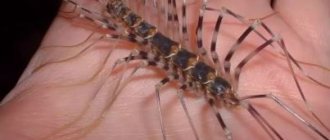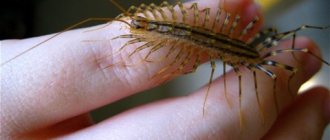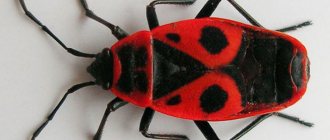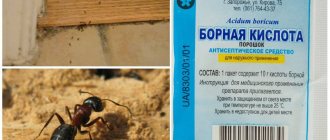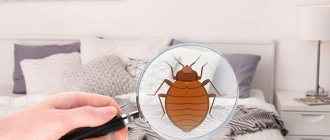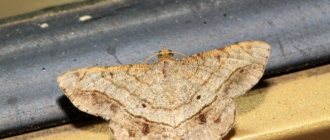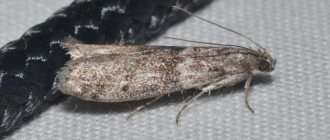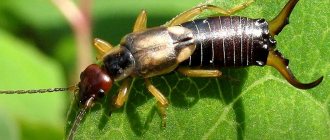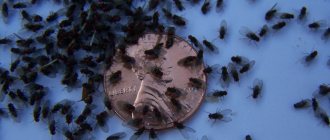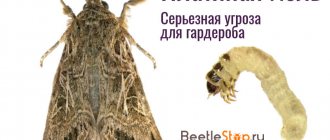The question of how to get rid of centipedes arises among those on whose territory they have settled. Centipedes are rare guests in houses and apartments; they do not cause material damage and do not threaten human health, while they destroy small pests, cleaning the area. But despite their relative safety and harmlessness, their appearance causes fear and desire to get rid of such neighbors as quickly as possible.
Centipedes are beneficial insects that destroy small pests that have settled in the house (cockroaches, flies, etc.). However, they frighten people with their appearance, which makes it necessary to look for methods of expelling them.
To combat centipedes, it is important to find out where they came from and where they live, as well as to create unfavorable conditions for their existence. Chemical preparations and folk remedies, the use of which is described in detail in the article, will help in exterminating the creatures.
Who are the centipedes in the house?
Centipedes, millipedes or millipedes are representatives of invertebrates.
Scolopendra.
These are mostly predators that feed on small insects, garden pests, ants, reptiles and even small rodents.
They love warm and humid places, so most of them live in the tropics and subtropics. In Russia they live mainly in the south.
Eliminate moisture
The main reason why centipedes appear in the house is the abundance of moisture. Once you get rid of it, the flycatchers will leave to look for a more suitable place to live. Therefore, it is necessary to carry out general cleaning and carefully inspect hard-to-reach places (behind the bathtub, toilet and under sinks). There may be water accumulating somewhere or a wet rag lying around. All wet areas should be wiped dry. Do not allow condensation to form on pipes or walls. This can often be observed after bath procedures. You should ventilate the bathroom and wipe the floor more often. If necessary, you can use a heater to dry the air. Wet towels and floor rags must not be left in the house. It is better to dry them outside or on an open balcony. It is also worth taking a closer look at the condition of the basement and attic. If water accumulation is found there, you will have to call a plumber.
Habitats of centipedes
Insects are ubiquitous in a house or apartment. However, encountering centipedes when the lights suddenly turn on will not be pleasant. Especially considering the speed and impressive views of this animal.
You can meet them:
- In bathroom;
- near a pond;
- under stones;
- in the trunks of rotting trees;
- places where litter is collected;
- compost pits;
- cellars;
- garages.
Prevention of occurrence
The main preventive measures include maintaining a high level of sanitary and hygienic condition of the premises. You simply won’t want to live in an apartment with an acceptable level of humidity, no accumulations of insects, or centipedes.
Additionally required:
- Eliminate possible “passages” through which insects can get into the living space. Caulk cracks in the walls and floors, install mosquito nets on the windows, coat the baseboards in the bathrooms with silicone glue.
- Carry out preventive treatment with insecticides of access routes to the premises that cannot be completely eliminated (for example, ventilation openings).
- If the level of humidity in the apartment is still high, ventilate it more often, remove a large number of house plants that require frequent watering, and do not dry clothes in the rooms after washing.
Compliance with these simple measures will protect your apartment from centipede invasion.
Varieties of centipedes
There are no species of centipedes that are adapted to life in the house. They go there in search of reliable shelter and sufficient food. There are several common species that live in houses and apartments.
This living creature looks unpleasant, it is small, but has thin curved legs. This insect is the leader in movement speed. This is an excellent house cleaner. It feeds on flies, cockroaches, fleas and other small insects.
flycatcher
A large number of species of this insect can be found everywhere. These are predators that actively eat many insects. They are not dangerous to humans, but they can bite unpleasantly and their venom is irritating.
Scolopendra
Description
Having seen a centipede once, you will no longer confuse it with anything, because its appearance is too memorable.
This arthropod can be yellow, pinkish, gray or brown. An adult specimen measures from 3.5 to 6 cm. Its body is divided into 15 segments and is flattened, thanks to which the centipede is able to crawl into the narrowest crevices. On the sides there are 15 pairs of legs that regenerate when lost, and their length is not the same (the further the pairs of legs are located from the head, the longer they are). The front legs are crowned with tenacious pincers, with which the centipede securely captures its insect victims, after which it injects its poisonous paralyzing secret into them, immobilizing the prey.
Juvenile centipedes (newborns) at this stage of life have only 4 pairs of legs, the number of which increases with each molt.
The centipede sees perfectly in light and in the dark: its compound eyes provide it with excellent vision. The arthropod also runs very quickly on all its legs, which lift its body above the surface while moving, so it is quite difficult to catch it with your hands. When running away, she is able to make sharp turns, while perfectly orienting herself in space thanks to her antennae.
How to get rid of centipedes in the house
If a nimble creature with a huge number of legs that moves almost at lightning speed is noticed in a room when the light suddenly turns on, grabbing a slipper will not help. It’s impossible to keep up with them, and it’s also difficult to kill many of them.
Make your home uncomfortable
The very first rule that will help get rid of centipedes in the house is to make it uncomfortable for them to exist. Here are some ways to help eliminate the settlement of living creatures:
- Remove insects that are of interest to centipedes. No food - no point in living indoors.
Centipede on the site.
- Remove dampness and places of stagnant moisture. High humidity is a comfortable place for animals.
- Monitor the condition of pipes, repair holes, update building materials and paintwork.
- Monitor the state of affairs in the cellar, attic and area, in all places where centipedes can live comfortably.
Traditional methods of getting rid of insects
The problem is that insects are not interested in simple food and will not bite on bait. You can, of course, spray or feed the insects that will become food with chemicals, but this is unlikely.
There are a number of drugs that will help remove centipedes. These baits will make their life unbearable; they act poisonously, even if they touch the body of the centipedes.
Sprinkle in places of residence:
- boric acid;
- Cayenne pepper.
Mechanical method
If possible, the centipede can be caught in a jar or sucked up with a vacuum cleaner. The further future is up to the person to decide - to kill or take the animal outside the site.
A good way to catch animals is sticky tape. It is laid out along the paths along which the scary roommates move. Even 30 pairs of legs will not save the animal from this trap.
Creating unfavorable conditions for the existence of pests
In order to independently get rid of centipedes in an apartment, it is necessary to create conditions unsuitable for their existence. First of all, deprive them of food - destroy the insects on which they feed, and the flycatchers themselves will leave the home.
Carry out repairs - seal the cracks through which pests enter, repair pipes and sewers. Get rid of excessive dampness: check the ventilation system, install dehumidifiers and regularly ventilate the room. Centipedes are moisture-loving insects and, in the absence of sufficient humidity, will leave the house in search of more comfortable conditions.
To expel flycatchers, get rid of high humidity in your apartment or house. To this end, check the ventilation, regularly ventilate the room or install a dehumidifier
How to get rid of centipedes on your property
Animals that live outside the house will not harm people. Only a meeting with a scolopendra can be dangerous. To deal with them you will need:
Scolopendras are unpleasant neighbors.
- Clean greenhouses and wood storage areas.
- Look in and move large stones and boulders.
- Check silage heaps and compost pits.
- Clear the house of rags and debris.
Is it worth destroying?
If order has been restored on the site and the yard has been cleared, the question will arise whether it is necessary to get rid of the centipedes. They eat garden pests, working for the benefit of gardeners.
There is a version that centipedes are garden pests. But even in the hungriest year, they prefer to move to other places in search of food rather than change their taste preferences.
A little about the species of scolopendra
In total there are more than 90 species of scolopendra. They belong to the family of labiopods. These are long insects, sometimes reaching 15 cm in length, with a segmented body and a large number of legs. Most often, scolopendra is yellowish or brownish in color. On an adult individual, three stripes of bluish or brown color can be found on the back.
https://youtube.com/watch?v=emIZooS9GN4%3Ffeature%3Doembed
In the process of evolution, the first pair of legs at the head of the centipede turned into pincers. It is at their expense that prey is caught. The domestic scolopendra is a predatory creature that actively consumes flies, cockroaches and bedbugs. Leads a nocturnal lifestyle. It can catch several insects at once and eat them for several days.
But if you do get bitten by a scolopendra, be prepared for the following consequences (we’ll warn you right away, not fatal). The bites can be very painful and go away slowly over 1-2 days. The main symptoms that you may experience: at the very moment of the bite there will be a sharp and prolonged pain,
the severity of the pain may vary (from slight to “10” on a 10-point pain scale), body temperature may increase, you may feel severe weakness, most likely, the sensitivity of the skin in the bite area will significantly increase, swelling and redness will appear, and may also loss of sensation and a feeling of numbness may occur.
Scolopendras are somewhat similar to wasps, which do not leave a sting in the wound and can sting a person several times in a row. Often, at the moment of detection by a person, this creature continues to inflict multiple punctures, introducing even more poison. Centipedes usually bite when a person is resting in bed, but they can also crawl into clothes and bite the moment you start getting dressed.
But there is good news: scolopendra bites are not fatal! For a person to die from its poison, he must be bitten by several thousand individuals at the same time!
Helpful advice: if you are bitten by a scolopendra, find a heating pad at home, fill it with moderately hot water (up to 45 degrees C) and apply it to the bite site - this simple measure should bring relief. Scientists have not yet found an explanation for this phenomenon, but they suspect that this is possible due to the fact that some components of scolopendra venom are unstable to heat. The second remedy is ice and analgesics.
And you don’t have to worry about clothes, paper documents, furniture and other items. A centipede is not a moth or a silverfish. She is not at all interested in your things. Another thing is that some centipedes can spoil the air in the house due to the fact that they secrete a bad-smelling secretion - but this is unlikely - there must be too many of these arthropods in your house for you to smell it.
We hope we didn't intimidate you. Therefore, at the end, in order to “whiten up” our heroes a little, let’s tell you how centipedes are useful. They are very active in destroying pests. Their diet includes bedbugs, flies, cockroaches, termites and even spiders. So sometimes centipedes turn into real “guardians of housing” from even more harmful creatures. Therefore, if you are not afraid of such many-legged neighbors, then live with them “in peace and harmony.”
Solutions
- Cifox – contains cypermethrin. A 50 ml bottle allows you to treat an area of up to 100 square meters to kill insects.
- Get is the most effective tool. A 100 ml bottle is dissolved in a liter of water. This amount is enough to spray a large room, including furniture.
- The executioner is an effective means of fighting. For a two-room apartment you will need 20-25 bottles. One bottle must be diluted with half a liter of water.
- "Cucaracha" is a powerful insecticidal drug. One bottle of 50 ml is enough to treat 100 sq.m.
- "Tetrix" - a remedy for blood-sucking insects. 30 ml of the drug is diluted with a liter of water. The mixture is sprayed or rubbed into surfaces.
- "Butox 50" - used for treating premises. Disinsection is carried out by spraying. Per 100 sq.m. It is necessary to dilute 30 ml of the drug with 10 liters of water.
- "Medilis" is a 25% emulsion concentrate based on the pyrethroid cypermethrin. For 1 sq. m. 50 ml of aqueous emulsion is consumed.
Reproduction
Centipedes lead a solitary lifestyle. In May and June they begin their breeding season. At this time, females begin to produce pheromones that attract males.
The fertilization process of centipedes is interesting. First, the male blocks the entrance to his home in the soil and deposits a sac with sperm - a spermatophore - into the resulting shelter. After this, the female crawls under the spermatophore, capturing it with her genital appendage. A few days later she lays eggs in the hole. The female creates a layer of sticky mucus on top of the eggs, which protects the offspring from predators.
One clutch can contain from 60 to 150 eggs. The female does not leave the clutch and drives other insects away from it. To prevent mold from appearing on the eggs, the centipede secretes a special substance whose composition resembles antifungal drugs.
Centipede larvae emerge simultaneously.

